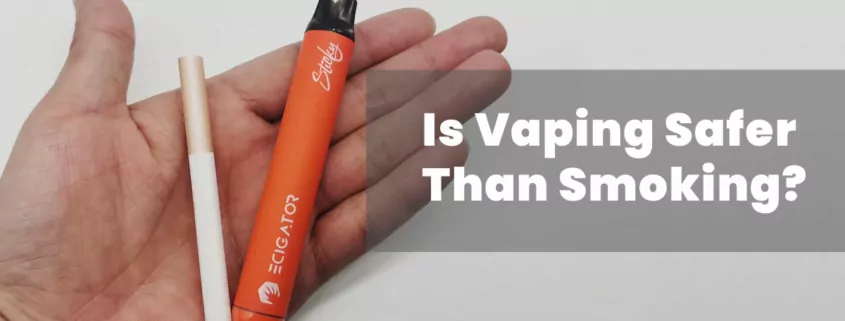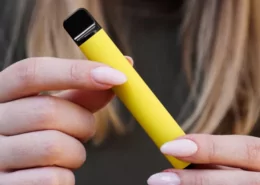Is Vaping Safer Than Smoking Cigarettes? Health Effects Compared
In recent years, the debate surrounding vaping and its potential as a safer alternative to traditional smoking has intensified. As new research emerges, both health professionals and the public seek to understand the relative risks and benefits of these two practices. This article aims to provide a detailed, evidence-based comparison of vaping and smoking, highlighting the potential advantages of vaping for current smokers looking to reduce harm.
What are Vaping and Smoking?
Before delving into the comparison, it’s crucial to understand what vaping and smoking entail:
What is Vaping
Vaping involves inhaling vapor produced by heating a nicotine-infused e-liquid in a battery-powered electronic device. This process creates an aerosol that users inhale, which contains significantly fewer toxic chemicals and carcinogens compared to traditional cigarette smoke. The e-liquid typically consists of propylene glycol, vegetable glycerin, flavorings, and nicotine (though nicotine-free options are available).
What is Smoking
Smoking refers to the burning of cured tobacco leaves in cigarettes, cigars, or pipes. This combustion process releases nicotine along with tar, carbon monoxide, and over 7,000 other chemical byproducts1. Smokers then inhale these substances directly into their lungs, exposing themselves to a wide array of harmful compounds.

Key Studies Comparing Vaping and Smoking
Recent research has shed new light on the relative health impacts of vaping versus smoking. Let’s examine some of the most influential studies:
The 2022 Cochrane Review
A comprehensive Cochrane Review published in 2022 analyzed findings from 78 previous studies focused on vaping [2]. This meta-analysis revealed several important points:
- E-cigarettes were nearly twice as effective for smoking cessation compared to traditional nicotine replacement therapies like patches or gum.
- Based on current data, vaping poses fewer potential health risks overall relative to continuing to smoke traditional combustible tobacco cigarettes.
- The review found no evidence of serious harm from e-cigarettes when used for up to two years.
The King’s College London Study
Researchers at King’s College London conducted a pivotal trial measuring exposure levels of various biomarkers associated with disease development among vapers and smokers. Their findings included:
- Significantly lower levels of cancer-causing agents and other toxic compounds in the bodies of e-cigarette users compared to cigarette smokers.
- Strong support for the harm reduction potential of vaping for current adult smokers.
- A cautionary note that some risks could remain, especially for younger non-smokers taking up regular vaping.
Is Vaping Less Harmful Than Smoking?
Based on the evidence presented in these influential reviews and other studies, a growing consensus suggests that vaping carries fewer health risks overall compared to traditional cigarette smoking. Here’s a breakdown of the potential benefits:
Reduced Exposure to Harmful Chemicals
The process of vaping eliminates the combustion that occurs in traditional smoking, thereby significantly reducing the number of harmful chemicals users are exposed to. While e-cigarette vapor does contain some potentially harmful substances, their levels are generally much lower than those found in cigarette smoke2.
Lower Cancer Risk
Studies have shown that the levels of carcinogens in e-cigarette vapor are significantly lower than those in cigarette smoke. A study published in the journal Tobacco Control found that the cancer risk from vaping is less than 1% of that from smoking3.
Improved Cardiovascular Health
Smoking is a major risk factor for cardiovascular disease. Research suggests that switching from smoking to vaping can lead to improvements in blood pressure, heart rate, and vascular health4.
Better Respiratory Function
Many smokers who switch to vaping report improvements in their respiratory symptoms, such as reduced coughing and shortness of breath. A study published in the Journal of Addiction Medicine found that smokers with asthma who switched to e-cigarettes experienced significant improvements in their asthma symptoms5.
Vaping as a Smoking Cessation Tool
One of the most promising aspects of vaping is its potential as a tool for smoking cessation. The Cochrane Review’s analysis found that using e-cigarettes boosted success rates in quitting traditional smoking nearly twofold compared to nicotine replacement therapies like patches, lozenges, or gum after 12 months.

Vaping appears to be effective for several reasons:
- It more closely replicates the physical motions and rituals involved in smoking, potentially better satisfying ingrained habits.
- E-cigarettes allow users to gradually reduce their nicotine intake over time, making the quitting process more manageable.
- The variety of flavors available can make the transition from smoking more appealing and enjoyable for some users.
However, it’s important to note that combining vaping with additional support tools like counseling and medication leads to the highest likelihoods of abstaining from smoking long-term.
Public Perceptions and Misconceptions
Despite the growing body of evidence supporting vaping as a less harmful alternative to smoking, public perceptions often lag behind the science. The King’s College study highlighted prevalent misconceptions among the general public regarding e-cigarette safety. For example:
- Only 34% of smokers correctly identified vaping as less harmful than cigarettes.
- Just 11% accurately recognized that nicotine itself is not the primary source of smoking-related disease.
These findings underscore the urgent need for better public education about the relative risks of vaping and smoking. Accurate information is crucial for smokers to make informed decisions about potentially switching to a less harmful alternative.
The Role of Flavors in Vaping
One aspect of vaping that has attracted both praise and criticism is the wide variety of flavors available. While some argue that flavors may attract non-smokers, particularly youth, to vaping, research suggests that flavors play a crucial role in helping adult smokers switch to e-cigarettes6.
A survey of adult vapers found that flavor variety was one of the most important factors in their decision to switch from smoking to vaping. Many ex-smokers report that moving away from tobacco flavors helped them disassociate from their smoking habit, making it easier to quit completely.

Ecigator Sticky Prefilled Pod Kit
The Ecigator Sticky Prefiiled Replaceable Vape Pod Kit is new kind of vape kit which the prefilled disposable pod can be changed.
That means you don’t need to throw away the whole kit but just change another pod. Also you can change the pods to taste different flavors.
Long-Term Considerations and Ongoing Research
While the current evidence strongly suggests that vaping is less harmful than smoking, it’s important to acknowledge that e-cigarettes are a relatively new technology. Long-term studies spanning decades are not yet available. Ongoing research continues to investigate potential long-term effects and refine our understanding of vaping’s impact on health.
As technology evolves and new products enter the market, continued vigilance and research are essential. Health organizations and regulatory bodies around the world are actively monitoring the situation and updating guidelines based on the latest evidence.
Conclusion: Making Informed Decisions
In summary, extensive research compiled in major recent reviews indicates that switching completely from traditional smoking to vaping can substantially reduce exposure to the myriad toxins and chemicals proven to lead to cancers, lung disease, heart disease, and shortened lifespans. For current smokers looking to reduce harm, vaping presents a promising alternative.
However, it’s crucial to remember that while vaping appears to be less harmful than smoking, it is not completely risk-free. The safest option is always to avoid both smoking and vaping. For those who don’t currently use nicotine products, starting to vape is not recommended.
For smokers considering the switch to vaping or individuals seeking to understand the relative risks, consulting with healthcare professionals and staying informed about the latest research remains crucial. As our understanding of vaping’s long-term impacts continues to grow, so too will our ability to make informed decisions about personal and public health.
References:
- U.S. Department of Health and Human Services. (2014). The Health Consequences of Smoking—50 Years of Progress: A Report of the Surgeon General. Atlanta: U.S. Department of Health and Human Services, Centers for Disease Control and Prevention, National Center for Chronic Disease Prevention and Health Promotion, Office on Smoking and Health. https://www.ncbi.nlm.nih.gov/books/NBK179276/ ↩︎
- Goniewicz, M. L., Knysak, J., Gawron, M., Kosmider, L., Sobczak, A., Kurek, J., … & Benowitz, N. (2014). Levels of selected carcinogens and toxicants in vapour from electronic cigarettes. Tobacco control, 23(2), 133-139. https://pubmed.ncbi.nlm.nih.gov/23467656/ ↩︎
- Stephens, W. E. (2018). Comparing the cancer potencies of emissions from vapourised nicotine products including e-cigarettes with those of tobacco smoke. Tobacco control, 27(1), 10-17. https://tobaccocontrol.bmj.com/content/27/1/10 ↩︎
- George, J., Hussain, M., Vadiveloo, T., Ireland, S., Hopkinson, P., Struthers, A. D., … & Lang, C. C. (2019). Cardiovascular effects of switching from tobacco cigarettes to electronic cigarettes. Journal of the American College of Cardiology, 74(25), 3112-3120. https://pubmed.ncbi.nlm.nih.gov/31740017/ ↩︎
- Polosa, R., Morjaria, J., Caponnetto, P., Caruso, M., Strano, S., Battaglia, E., & Russo, C. (2014). Effect of smoking abstinence and reduction in asthmatic smokers switching to electronic cigarettes: evidence for harm reversal. International journal of environmental research and public health, 11(5), 4965-4977. https://www.ncbi.nlm.nih.gov/pmc/articles/PMC4053879/ ↩︎
- Russell, C., McKeganey, N., Dickson, T., & Nides, M. (2018). Changing patterns of first e-cigarette flavor used and current flavors used by 20,836 adult frequent e-cigarette users in the USA. Harm reduction journal, 15(1), 1-14. https://harmreductionjournal.biomedcentral.com/articles/10.1186/s12954-018-0238-6 ↩︎
- Is It Illegal to Vape or Smoke While Driving in Massachusetts? - August 5, 2025
- Austria Plans to Ban Disposable E-Cigarettes - August 5, 2025
- Vaping vs. THC Drinks: Which Cannabis Option Is Right for You? - August 4, 2025









